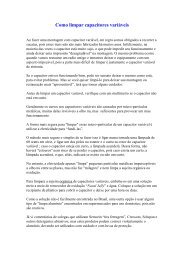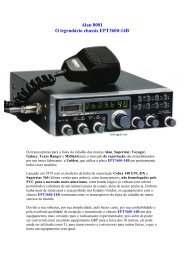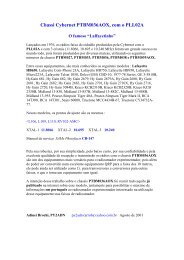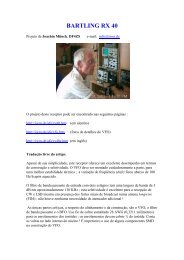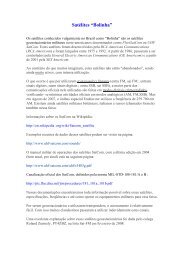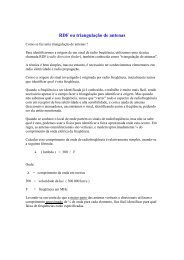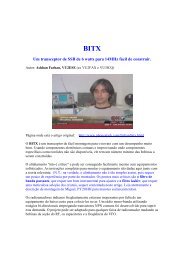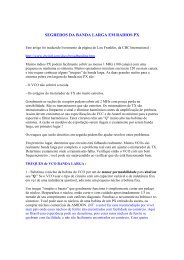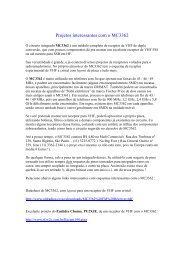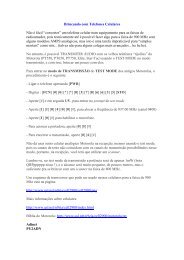COURIER GLADIATOR manual de serviço, com ... - PY2ADN
COURIER GLADIATOR manual de serviço, com ... - PY2ADN
COURIER GLADIATOR manual de serviço, com ... - PY2ADN
Create successful ePaper yourself
Turn your PDF publications into a flip-book with our unique Google optimized e-Paper software.
Como a modificação <strong>com</strong> chaves thumbweel funciona :<br />
Os pinos <strong>de</strong> programação do PLL uPD858 são divididos em três blocos :<br />
http://malzev.tripod.<strong>com</strong>/<strong>com</strong>p/upd858.htm<br />
“Each <strong>de</strong>cimal group can only have a maximum of 4 bits. In this IC there are only 10<br />
rather than 12 program pins so the Hundreds Group can never be worth more than (1 +<br />
2) x 100 or 300. Just figure the total binary value of each group in the usual way,<br />
multiply it by 1, 1O, or 100 as appropriate, then add all the groups together: 0nes<br />
Group + Tens Group + Hundreds Group, etc.<br />
Since each group has a value, the sum of the groups is the N-Co<strong>de</strong>. For Ch.1, the group<br />
sum is 1 + (10 + 80) = 91. Try the math yourself for the other channels. Also notice that<br />
Pin 22 is permanently groun<strong>de</strong>d (logic "0" ) since its BCD weight is "200", but we never<br />
need a co<strong>de</strong> bigger than "135." (100 + 30 + 5.) By using all ten pins (pins 13-22) you<br />
see there's a potential frequency capacity of (9 + 90 + 300) = 399 channels if you could<br />
.program them all. This fact has been put to great use in modifications! 0nce again, the<br />
uPD858 chip had the excess capacity for possible use elsewhere.”<br />
Assim, o uPD858, que utiliza pinos <strong>de</strong> programação BCD, divididos em três blocos<br />
(unida<strong>de</strong>s, <strong>de</strong>zenas e centenas) tem quatro pinos que apenas correspon<strong>de</strong>m às unida<strong>de</strong>s,<br />
quatro para <strong>de</strong>zenas e dois para centenas, portanto, é possível fazer a substituição do<br />
seletor <strong>de</strong> canais por três chaves thumbweels.<br />
Para não fazer besteira, faça antes um teste prático : tendo <strong>com</strong>o base a “tabela<br />
verda<strong>de</strong>”do uPD858, monte fios em três thumbweels, ligando o “C” em 5 volts.<br />
Dessa forma, faça a leitura dos pontos <strong>de</strong> tensão positiva e veja se “coinci<strong>de</strong>m” <strong>com</strong> a<br />
tabela verda<strong>de</strong> do PLL em questão, simulando a chave seletora <strong>de</strong> canais. Ou seja,<br />
simule a chave.<br />
Se funcionar corretamente, indicando a mesma leitura da tabela verda<strong>de</strong> do PLL, o<br />
problema está resolvido !<br />
Importante : os pinos <strong>de</strong> programação <strong>de</strong> um PLL que não estiverem “altos” não<br />
po<strong>de</strong>rão ficar “flutuantes”, pois <strong>de</strong>vem ficar aterrados. Dessa forma, faça aterramentos<br />
<strong>de</strong> “pull-down”, aterrando todas as trilhas do PLL.<br />
Para não se “per<strong>de</strong>r” na localização <strong>de</strong> freqüências, já que a leitura <strong>de</strong> canais na chave<br />
será pelo código N do thumbweel, que no caso dos rádios <strong>com</strong> o PLL uPD858 o Código<br />
N é 91 para o canal 1 a 135 para o Canal 40, será necessário a utilização <strong>de</strong> uma tabela.<br />
Para resolver o problema, basta utilizar um frequencímetro externo <strong>com</strong> f.i.<br />
programável, pois ai teremos a leitura exata <strong>de</strong> freqüência.<br />
Dessa forma, a solução mais simples para uma modificação num radio <strong>com</strong> seletor para<br />
23 canais <strong>com</strong>o o Courier Gladiator é a utilização <strong>de</strong> três chaves thumbweel.



